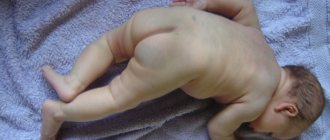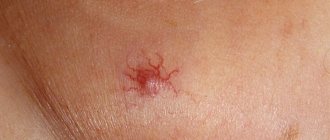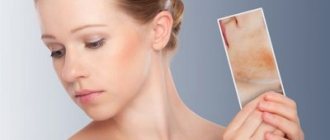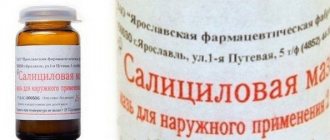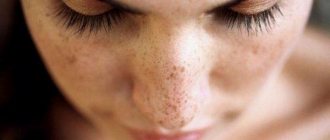Red spots in the groin are a cause for concern for many men, but not many decide to seek help and advice from a doctor. Some chalk it up to an allergy, while others wait for it to go away on its own. And if in some situations red spots in the groin area can indeed suggest harmless causes, then sometimes such a sign is a consequence of a serious illness.
First of all, to find out the reasons for this phenomenon, you should pay attention to the lifestyle, nutrition, hygiene and clothes that a man wears. If redness appears only for a short period of time, most likely this is a reaction of sensitive skin to synthetics, high temperatures, and other negative external factors. If redness and itching appear for a long time, an examination by a specialist is necessary.
What could cause redness in the groin in men?
Most often, redness of the skin in the groin area in a representative of the stronger sex can be a consequence of such negative factors as wearing tight underwear made of artificial fabrics, hot weather conditions, as well as all kinds of household chemicals and personal hygiene products that cause skin irritation. Rash, peeling and red spots may also indicate the presence of serious diseases of fungal or infectious etiology.
Athlete's inguinal
A serious disease such as athlete's foot is a consequence of exposure to a fungal pathogen. Most often, patients with this diagnosis are adult men; infection occurs through contact and household contact.
Inguinal athlete's foot can be distinguished by the following characteristics:
- redness on the thighs, perineum and groin, in the form of pink round spots up to 1 cm wide;
- peeling and excessive itching in these places;
- gradual increase in spots up to 10 cm wide;
- the edges of the spots are demarcated;
- in the area of redness there is a rash with liquid or pus inside.
After some time, the redness in the center of such a spot disappears, remaining only at its periphery. A man faces not only severe itching, but also pain in the legs during active movement. Nervousness and irritability, an unstable emotional background can also be considered accompanying symptoms.
Erythrasma
Redness of the skin in the genital area in a man can be caused by a pseudomycosis disease - erythrasma. In fact, the causative agent here is a rod-shaped pathogenic bacterium, which is an opportunistic microorganism. This means that the pathogen is constantly in the human body, but manifests itself only against the background of weakened immune defense.
The causes of relapse of pathology can be:
- excessive sweat production, against which the skin becomes saturated with it, forming diaper rash;
- hot climate and high humidity;
- diabetes;
- mechanical injuries to the skin - friction, scratching, wounds and scratches of the epidermis;
- excess weight.
You can become infected with erythrasma, as in the previous case, through contact and household contact, as well as during sexual intercourse. In this case, the following manifestations can be considered symptoms of the disease:
- redness in and around the groin area;
- peeling;
- the appearance of round spots of red, brown, yellowish or brick color;
- rash around the spots and characteristic itching;
- after a while, the redness goes away, remaining only on the periphery of the spots;
- the redness has clearly demarcated edges and an unpleasant specific odor.
If infection penetrates into the affected areas due to scratching, the rash may fester. Erythrasma may not manifest itself this way for all men; it all depends on the level of resistance of the body.
For reference!
In addition to the above diseases, redness in the groin can be caused by lichen, fungi, herpes, hormonal disorders and internal diseases, infections.
How to treat
In medicine, to make an accurate diagnosis, they take blood from a finger, blood from a vein, or scraping from the affected area.
Diaper rash is treated with a variety of liquids, creams, and ointments. First, they are treated with an antiseptic drug, then with drying ointments, healing and anti-inflammatory or complex ointments, which have all these properties. That is, they use zinc ointments, Boro Plus, Zhivitsa and many others. In advanced stages, when an infection occurs, more serious treatment must be used. We'll look at this later in the article.
To treat allergies, ointments Advantan, Sinaflan, Gistan, Elokom and others are used. In severe cases, I prescribe tablets such as Suprastin, Loratadine, Erius, vitamin complexes and immunomodulators.
For the treatment of diseases such as seborrhea, psoriasis, atopic dermatitis, vitamin complexes are prescribed; vitamins may differ in composition. Vitrum and Complivit are often prescribed; they are developed taking into account the complex of minerals and vitamins necessary to improve hair, skin, and nails. Also prescribed are tablets, capsules, and syrups to enhance immunity: “Imupred”, “Imunoris”, “Echinacea”.
And of course there are ointments, there are a lot of ointments for treatment, be careful, do not switch to hormonal ointments yourself, such as “Belosalik”, “Dermosalik”, these ointments are addictive, destroy bones, are prescribed in extreme conditions, although they temporarily help relieve inflammation. That is why, before you try anything, you need to go to an appointment with a doctor and agree with him.
As for infectious diseases, treatment in the form of vitamins, ointments, immunomodulators, long-term use of antibiotics, and various types of suppositories is used.
What medications to use, it all depends on what type of bacteria or fungi is causing the inflammation. In no case should you use medications without a doctor’s prescription, without knowing the diagnosis, since many medications that treat one inflammation can intensify another.
Similar article - Hands peeling on the palms
Conclusion
Doctors warn! Shocking statistics - it has been established that more than 74% of skin diseases are a sign of parasite infection (Accarida, Giardia, Toxocara). Worms cause enormous harm to the body, and the first to suffer is our immune system, which should protect the body from various diseases. The head of the Institute of Parasitology shared the secret of how to quickly get rid of them and cleanse your skin, it turns out that’s enough. Read more .
Having examined the causes and some diseases, you understand that it is very difficult to distinguish one from the other by appearance. Therefore, to establish an accurate diagnosis, it is necessary to visit a doctor.
Athlete's groin is a chronic disease caused by a fungus that affects the epidermal layer of skin mainly in the groin area. The main morphological element of the pathology is a scaly pink spot with pustular rashes located along the periphery. The lesions itch and cause discomfort to patients. Athlete's groin is a delicate disease that leads to sexual dysfunction, decreased libido and sexual arousal.
The disease affects men more often than women. In children and adolescents, the pathology develops extremely rarely. The spread of fungal infection occurs through household contact through direct contact, through household items, personal hygiene products, and cosmetics. With a decrease in the general resistance of the body, a primary focus is formed at the site of entry of the pathogen, which gradually grows along the periphery and spreads to healthy skin. The main location of the fungus is the inguinal folds. In more rare cases, the disease can affect the skin of the buttocks, scrotum, perineum, penis, inner thigh, and pubic area. In women, the skin under the mammary glands, in the armpit and popliteal fossa often becomes inflamed.
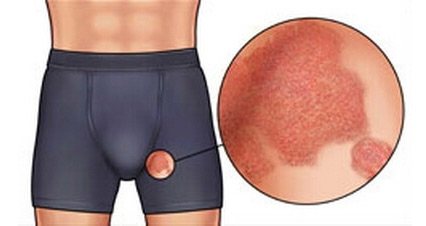
Fungi of the genus Epidermophyton floccosum settle in the epidermis of the skin, destroy and utilize collagen, which leads to a decrease in the elasticity of the skin. Microorganisms have a low degree of pathogenicity, so the disease rarely develops in healthy people with full immune protection.
The diagnosis of pathology is made after microscopic detection of fungal mycelium in scrapings from the surface of spots and obtaining the results of bacteriological examination of biomaterial from patients.
Groin fungus requires a patient and careful approach. Causal treatment involves the use of antimycotic drugs that can completely cure the disease.
How to treat redness and what to do?
Initially, a man should reconsider his lifestyle, give up synthetic fabrics in clothes, start using hypoallergenic personal hygiene products, avoid excessive sweating (for example, using powders and talcum powder), and improve personal hygiene. If the redness and rash were caused by bacteria or fungi, treatment of the disease involves local treatment, as well as antifungal therapy and the use of antibiotics.
- In the case of inguinal athlete's foot,
local therapy can be used by the following means:
- ointments Mikoseptin, Triderm, Clotrimazole or other antifungal gel;
- tincture of Fukortsin and iodine;
- 0.25% solution of silver nitrate for lotions;
- 1% resorcinol solution.
Every day a man needs to take baths with herbal decoctions to disinfect and relieve inflammation. General treatment involves the use of such agents as antiseptics Suprastin, Diphenhydramine or Diazolin, as well as vitamin complexes and immunostimulants.
- For inguinal erythrasma,
therapy involves a certain set of measures:
- applying sulfur-tar ointment, erythromycin or Wilkinson's drug to the affected skin;
- therapy with the antibiotics Doxycycline or Erythromycin;
- ultraviolet irradiation.
In addition, the doctor may prescribe sedatives to relieve the clinical picture of the disease. Also, during the treatment period, you should avoid sexual intercourse and visiting public places, such as saunas or swimming pools.
Simple methods of prevention
It is much easier to prevent any human disease than to try to cure it later. As for the causes of irritation and redness in the groin area, the best preventive measure is personal hygiene and its regular observance. It is important for a man to wash himself with soap twice a day and change his underwear daily. In addition, you cannot turn a blind eye to sweating; this symptom also requires action.
You can protect yourself from infections and disease by using condoms during sexual intercourse, as well as supporting your immune system. Men's underwear must be made from natural fabrics of loose tailoring. Any spots or redness in the genital area should be shown to a medical professional.
It’s better not to joke with men’s health, remember this! The best way to deal with the disease is to make an appointment with a good doctor!
Be the first to comment
Darkening of the skin in the groin in men can appear at any age and even for no apparent reason.
Although most men are not as partial to their appearance as women, and darkening does not bother them, you should definitely pay attention to such a phenomenon. It may be a sign of the onset of serious illness.
Why do spots appear in the groin folds?
Pigment spots that appear in men's groin folds can be of different colors and different shapes. Their appearance is sometimes accompanied by pain and swelling. But it happens that they are discovered unexpectedly, and it is unknown when the spots appeared.
- Sometimes dark spots occur as an occupational disease. Men who have to be naked at work often remove excess hair, causing microtrauma to the skin. Pigmentation appears as a result of injury to the epidermis, which produces melanin.
- Wearing tight underwear also causes microtrauma, causing age spots in the groin in men.
- Dark brown spots or black pigmentation may be a symptom of stomach cancer. In this case, they are quite dense in structure, their surface is velvety to the touch.
- The skin darkens in the inguinal folds with Addison's disease. This is a fairly rare disease during which the adrenal glands lose the ability to produce enough hormones to ensure normal functioning of the body. Basically, the reproduction of cortisol is disrupted. In addition to the groin, the nipples and armpits darken.
- The groin area changes color in diseases associated with changes in the functioning of the gallbladder and liver.
- The skin in the groin changes color due to chemical poisoning. Most often this happens when the accumulation of harmful substances occurs gradually. This is usually associated with professional activities.
- Pink pigment spots most often indicate the presence of a fungal infection or pityriasis versicolor. Their appearance is accompanied by itching, peeling, and soreness of the skin. If treatment is not started on time, the disease spreads to the buttocks and legs.
How to remove darkening in the groin area
Before you begin to combat discoloration of the skin in the groin, you need to establish the cause of the darkening. Dark spots on the skin are a sufficient reason to visit a dermatologist.
The doctor can diagnose darkening of the skin in the groin associated with microtraumas by additional swelling and pain when touched. But even after treatment of microtraumas, skin color is not always restored. If restoration of the aesthetic appearance is necessary, then you will have to resort to laser correction.
If serious conditions associated with systemic or oncological diseases have been diagnosed, then these diseases are subject to treatment.
Violation of the normal functioning of the liver or gall bladder is corrected with special medications, which should only be prescribed by a doctor. This may be drug therapy or remedies from the arsenal of traditional medicine. As soon as the liver and gallbladder function returns to normal, the brown spots will lighten.
A course of antifungal therapy will return the inguinal folds to their normal color if they have darkened due to the colonization of mycelium spores.
It’s not just Candida that has chosen these places among men. Eczema fringed or athlete's foot inguinal is considered a typically male disease. Risk factors for fungal infections are:
- disturbance of carbohydrate metabolism;
- increased sweating;
- violation of intimate hygiene rules.
Fungal infection is transmitted through direct contact with carriers of the disease and through objects used by the patient.
Pityriasis versicolor is treated with products that exfoliate the top layer of the epidermis. The method of spread of the pathogenic filamentous fungus Microsporon furfur is the same as that of other fungal infections, but additional symptoms - skin itching, burning, peeling - are not present when spots form. The disease is not contagious and does not cause any other problems other than cosmetic damage.
How to get rid of stains?

Before you learn how to get rid of brown pigmentation on the skin in the groin, the cause of the occurrence is determined. Without eliminating the cause, irritations will continue to appear. If the appearance of pigmentation is associated with injury, then brown skin can remain for life; the normal shade of the affected skin area can be restored with the help of laser correction.
When the cause is systemic or oncological diseases, then first you need to cure them. By eliminating the root cause of the pathology, self-removal of the stain is possible. If the appearance of pigmentation is associated with the introduction of a fungus, then treatment is prescribed using systemic and local antifungal agents:
- "Nitrofugin";
- "Mikoseptin";
- "Clotrimazole";
- "Dermozolon";
- "Nizoral";
- tablets "Terbinafil" and "Orunit";
- Triderm ointment.
Therapy continues from 1 month or longer, depending on the course of the disease and the condition of the skin. Treating the epidermis with a 2% alcohol iodine solution or an antiseptic solution prevents the disease from returning. The treatment complex includes taking immunostimulating drugs. It is not recommended to treat the fungus on your own; the course of treatment is prescribed by a doctor after diagnosis and determination of the root cause.
Prevention of darkening of the inguinal folds
To prevent or aggravate discoloration of the skin in the groin area in men, you need to follow fairly simple rules:
- Maintain personal hygiene.
- Do not use items that have been used by another person.
- In bathhouses, saunas and other similar establishments, do not come into contact with benches and shelves with bare skin.
- Try to avoid micro-traumas of the skin and do not overuse tight synthetics. Give preference to underwear made from natural fabrics.
- Fight excessive sweating, treat the groin folds with special means, and prevent the formation of excess weight.
Of course, these rules cannot protect you from systemic diseases or organic changes in the body. But if you consult a doctor in time, then serious damage to the body caught at an early stage can be stopped.
Hyperpigmentation of the groin area may be an indicator of serious damage to the body.
Always cause concern. But most representatives of the stronger sex are in no hurry to see a doctor. Some people think that this is a common allergy that will go away on its own. Others are simply embarrassed to tell someone about such a sensitive issue. And if for some guys the unpleasant symptom disappears safely without treatment, then for others the progression of a serious illness leads to complications.
Have you had a full medical examination in the last 5 years?
Not really
That is why it is worth familiarizing yourself with the signs of common pathologies in which red spots appear in the groin area.
Review of root causes
Here is a list of the most common reasons why red spots of various shapes and sizes may appear in the groin area in men.
| Cause | Description |
| Allergy | If such rashes appear spontaneously and disappear in a short period of time, then contact dermatitis can be assumed. The red spots itch and often become infected and painful from scratching. It's all due to synthetic underwear or new washing powder or shower gel. To get rid of discomfort, it is enough to identify and remove the irritant. |
| Prickly heat | Red spots in the groin in men without itching occur in the heat and with overheating and increased sweating. Against the background of hyperemia, a small weeping rash appears, and the skin is painful when touched. It is important to ensure regular hygiene of the groin area; rashes can be treated with a decoction of herbs and baby powder. |
| Rubromycosis | You can catch the pathology in rooms with high humidity. This fungus affects large folds of the groin. In advanced cases, the rash spreads to the buttocks and thighs, scrotum and very rarely affects the penis. Small bubbles appear along the edges of the rash. After some time, red spots in the groin of men with itching turn into rings - the main sign of rubromycosis. The disease is treated with topical antifungal ointments and creams. |
A fungal disease is more common in adult men infected through contact and household contact. An infection can be recognized by the presence of the following symptoms:
As the disease progresses, only the edges of the spots remain inflamed, and the middle takes on a skin tone. Due to severe itching and scratching, the man experiences pain that interferes with movement. It can also be observed on the legs. The person becomes irritable, nervous, and sleeps poorly. Treatment of the disease is carried out with local antifungal agents. | |
| Erythrasma | Moderate itching and red spots in the groin in men are characteristic of pseudomycosis. An opportunistic microbe that infects the skin constantly lives on its surface. But under the influence of favorable factors and against the background of a weakening of the body’s immune defense, it begins to multiply rapidly. Contribute to this:
It is also possible that infection with erythrasma occurs during sexual intercourse or through household contact. Redness in the groin is accompanied by peeling and an unpleasant odor. The shade of the spots can be pink, yellow and even dark brown. A small itchy rash appears along the edges. Damaged skin is treated with sulfur-tar ointment. And when a bacterial infection occurs, antibiotics are indicated. |
| Venereal diseases | A red, spotted rash in the genital area appears in the secondary period of syphilis, 7–10 weeks after the primary infection. In the absence of therapy, the rash disappears, and the disease enters a chronic latent stage. Skin hyperemia and itching are characteristic of herpes infection. Later, bubbles filled with cloudy liquid appear in these areas. After a while they burst, leaving painful ulcers. Within 1–2 weeks, the wounds heal without a trace. |
| Ringworm | or bright red spots in the groin in men without itching - a sign of dermatosis. The reasons for its development lie in increased sweating, heat, decreased immunity and exposure to solar radiation. The diameter of the spots ranges from 1 to 12 cm, the lesions tend to merge. Therapy is carried out with antifungal and antiseptic drugs. |
Any of the listed reasons should be a reason to consult a doctor, since ignoring the problem can lead not only to the progression of a possible disease (appearing on the genitals), but also to infection of sexual partners.
Symptoms
single spot of athlete's foot
With inguinal athlete's foot, pink or red-brown spots appear on the skin, having a round shape and a diameter of no more than one centimeter. The spots are located symmetrically, itch, peel and gradually grow. Along the periphery of the spot on hyperemic and edematous skin, multiple blisters, pustules, suppurations, crusts and small flaky inclusions appear. Foci of inflammation are limited to an edematous ridge. Plaques can merge with each other, forming a single erythematous area that spreads to surrounding tissues. Itching and burning are especially felt when walking, squatting and while bathing.
As the inflammatory process subsides, the central part of the spot becomes clean, pale and slightly sunken. This gives foci of epidermophytosis a special appearance of rings and is a pathognomonic sign of pathology. Fungus in the groin in men itches and burns, and severe discomfort occurs when walking. The areas are painful to the touch. Vesicles and pustules can burst, forming erosions and ulcers. When a secondary bacterial infection occurs, severe complications develop.
Photo: inguinal athlete's foot in men and women
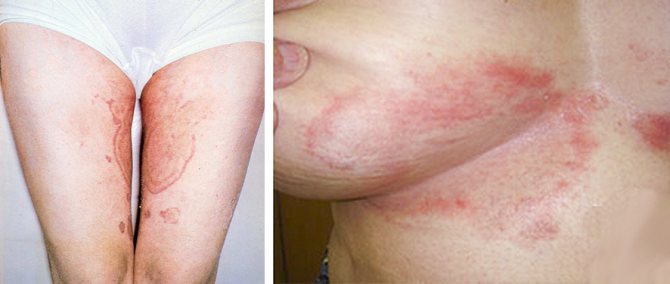
Additional symptoms of athlete's foot include swelling of the groin area, hyperemia of nearby skin, and the appearance of specific blisters with turbid serous fluid. With epidermophytosis, not inflammatory, but allergic rashes - epidermophytide - may appear on the skin. They are located symmetrically, do not contain fungi and disappear on their own after undergoing antimycotic treatment.
In the absence of timely and adequate treatment, the disease can last for years. Athlete's disease is characterized by an acute or subacute course with pronounced signs of inflammation. The disease quickly becomes chronic and takes on a wave-like course, during which periods of remission are replaced by exacerbations, forming from time to time new foci of skin lesions. Even after complete recovery, the disease can recur.
Constant stress, friction in the affected area and hyperhidrosis complicate the course of the pathology.
Red spots in the groin in men photo
Protection against fungus and sexually transmitted infections can be achieved by using a condom. However, only a strong immune system can suppress dangerous pathogens without giving them a chance to reproduce. That is why it is important to comprehensively strengthen the body, eat a balanced diet, maintain sufficient physical activity, not overwork, and treat colds and respiratory diseases in a timely manner.
Spots on the inner thigh in men: photos, causes, treatment Red spots on the inner thigh in men: photos, causes, treatment
If brown spots appear in the groin of men, it is important to pay attention to the accompanying symptoms of this phenomenon. There are many factors that cause brown spots to appear.
It is important to understand what it is and how to treat the pathological condition, as well as find out how dangerous it is to health.
Causes
However, there are other reasons that provoke. It is recommended to additionally carefully study photographs of the manifestations of each disease. The list of reasons is given below.
Common reasons
The main factors are:
- influence of fungal microflora. All areas of the skin that are hidden from sunlight and in which excess moisture appears are optimal for the development and spread of pathogenic fungi. Skin cells called melanins begin to break down from exposure to pathogenic fungi. Often, darkening of the skin in the groin occurs due to the development of fungi from the genus candida. The active development and reproduction of the fungus can be provoked by tight clothing made of synthetics or by neglecting the rules of personal hygiene;
- damage to the skin. This often happens during shaving or hair removal. After this, you can observe the formation of brown spots in the groin area;
- development of the inflammatory process in the intimate area. After the inflammatory process in the groin begins, melanin stops being produced and the skin darkens in some areas. In other words, the phenomenon is called post-traumatic pigmentation;
- presence of infectious diseases. Due to the active development of bacterial microflora, which provokes infections, the epidermis is destroyed as bacteria feed on healthy cells. This leads to the formation of pigment phenomena;
- disruption of the hormonal system. The consequence of an imbalance in the hormonal system is the appearance of pigmented rashes in men. This phenomenon often occurs during puberty;
- chemical poisoning. Some chemicals destroy melanin or disrupt the process of chalk genesis. This leads to the formation of pigmented areas in the groin area;
- the presence of chronic diseases of the liver, gall bladder or gastrointestinal tract;
- Addison's disease, due to which the functioning of the adrenal glands is disrupted and, accordingly, the production of the required amount of hormones stops.
Diseases
The following pathologies are characterized by the appearance of brown spots in the groin in men:
- Allergic type dermatitis. A characteristic symptom for this pathological condition is itching and flaking. A stain or several may appear in the intimate area due to any irritating substance, for example, aggressive cosmetics, lubricants, condoms, lubricants or underwear made of synthetics, both bed and underwear. Additional symptoms are swelling and hyperemia of the irritated area of the skin. Subsequently, the appearance of blisters and red pimples is observed.
- . The disease is caused by bacteria from the genus Corynebacterium. After their impact on the skin, red spots appear in the groin area. This phenomenon is not accompanied by pain or any other discomfort such as burning or itching. Men who neglect the rules of personal hygiene are most often exposed to pathogenic microflora.
- Athlete's foot (inguinal). It occurs when light brown spots form on the pubic area. In some cases they have a rounded shape. An additional symptom is pronounced itching. In some cases, the size of the lesion reaches 10 cm in diameter. The initial stage of epidermophytosis is characterized by slight redness of the skin, while the formations are smooth and inflammation in their central area is clearly visible. After some time and with the development of the disease, the boundaries of the inflamed area begin to blur, and the reddened areas of the skin begin to merge with each other. At this stage of the disease development, a pustular rash also appears along the edges of the lesion. The spread of both spots and rashes is observed throughout the intimate area and on the inner thigh. The rash also covers the external genitalia and anus. You can become infected with epidermophytosis through contact with a carrier of the fungus or while using his personal belongings.
- Rubromycosis. It is characterized by the appearance of redness in the groin area, which is accompanied by itching. The size is about 2-3 cm in diameter. The pathology is caused by the Trychophyton fungus. In addition to the fact that the fungal microorganism develops on the epidermis of the skin, it subsequently affects the hair follicle. After penetration into the root of vellus hair, loss of shine and fragility is observed. The disease is transmitted through direct contact with a carrier of the infection or through contact with household items on which a viable fungal infection remains.
- Psoriasis. The pathology is characterized by the appearance of small lesions; they can be red or red in color. The difference between them is that there are skin flakes on the surface of such areas. They look like pigmented ones, without itching, but with peeling. If you do not treat and suppress the disease, the lesion begins to grow and increase in size, peeling increases and itching appears. The causes of this disease are not fully understood, however, in most cases the nature of its occurrence is psychosomatic.
- (red). Darkening of the skin in the groin can provoke this disease. Often the pathology is characterized by the appearance of plaques, red, brown, or brown. Their surface is dense, shiny, the boundaries of the formations are clearly visible. An additional symptom is pronounced itching. Small spots merge in a short period of time, forming large lesions. A characteristic sign of the disease is a mesh pattern on the surface of the localization site.
What are pink spots on the pubic area?
In almost all cases, skin rashes indicate the development of an inflammatory process in the body. If red spots appear on your pubic area, you should consult a doctor. This is due to the fact that rashes in intimate areas often serve as a symptom of various ailments.
Less commonly, spots occur for a number of other reasons not associated with diseases. The doctor will conduct diagnostic measures and prescribe treatment based on the research results. Below are the most likely causes of red spots on the pubic area (a photo of the rash is presented below).
Ftiriaz
This term refers to a parasitic pathology that belongs to the group of sexually transmitted infections. Another name for the disease is pediculosis pubis.
Typically, lice are spread through close contact with an infected person. The risk group includes the following categories of people:
- Leading a promiscuous lifestyle.
- Adult film actors.
- Homeless.
- Workers of saunas, baths and dry cleaners.
- People who are serving sentences in prison.
- Workers of child care institutions.
- Military personnel who live in barracks.
It is important to know that from the area of primary infection, pubic lice can easily move to the intimate part of the body. As a rule, the pathogen affects the pubis, anus and perineum.
The main symptom of phthiriasis is severe itching. Red spots appear in places where scratching occurs. On the pubic area you can also notice a large number of skin flakes resembling dandruff.
The treatment regimen for lice pubis includes the use of insecticides that destroy lice, preventive measures and treatment of the skin of people who have been in close contact with the patient.
Psoriasis
This term refers to a dermatological disease that significantly worsens a person’s quality of life, especially sexual life.
The disease can develop for the following reasons:
- overstrain (both physical and mental);
- weakening of the body's defenses;
- disruption of the functioning of the organs of the reproductive system.
Genetic predisposition plays an important role.
The disease has specific symptoms. The main symptom is red spots on the pubis, covered with white scales. The boundaries of the rash are clear. In this case, patients are usually not bothered by itching.
With psoriasis in women, red spots on the pubis can be confused with vulvitis. They can also be located on the labia and mucous membrane. In this regard, if rashes appear, you should consult a gynecologist. Only a specialist will be able to carry out differential diagnosis and accurately determine the disease.
In men, spots can be localized not only on the pubis, but also in the folds of the groin and on the penis.
The treatment regimen for psoriasis includes the following points:
- Local application of hormonal ointments and creams.
- Taking antihistamines.
- Physiotherapy.
- A therapeutic diet.
Psoriasis is an autoimmune disease. This means that the disease is not transmitted to a partner through sexual contact.
Dermatophytosis
This is a pathology caused by mold fungi. The disease is most often diagnosed in men, women and children; the disease affects very rarely.
The infection is transmitted from animals, infected people and through the soil in which the pathogen lives. In this regard, the risk group includes the following categories of people:
- with a weakened immune system;
- paying insufficient attention to compliance with hygiene rules;
- regularly ride horses;
- agricultural workers;
- frequently using other people's personal items (for example, bath towels).
- Red spots on the pubis. In both men and women, they can be localized in the groin, thighs and buttock folds. The rashes are highly inflamed and symmetrical. The boundaries between them and healthy skin are roller-shaped.
- Pronounced itching and burning.
- Pustules and blisters often form.
To treat the disease, the use and external use of antifungal agents is prescribed. In addition, the skin must be treated with antiseptics. An important step in the treatment of dermatophytosis is regular adherence to hygiene rules.
Scabies
This is a parasitic disease, the causative agent of which can only infect the human body. The scabies mite can move from other parts of the body (from areas of primary infection), gnawing passages in the skin. But at the same time, the genital form of the disease often develops after sexual contact with an infected person.
The first alarming symptoms appear 3 days after infection. Clinical manifestations of the disease:
- Unbearable itching. Its severity increases in the evening and night hours.
- White or gray stripes on the skin are tick burrows.
- Red spots on the pubis, labia, scrotum, glans and foreskin of the penis.
Ignoring the disease leads to the development of complications, which are extremely difficult to get rid of. In this regard, it is necessary to promptly consult a doctor who will select the most effective anti-scabies.
Source: https://borodaprofi.ru/medicina/rozovye-pjatna-na-lobke-chto-jeto.html
Treatment
In order to determine treatment and get rid of pigmentation on the skin, it is important to correctly identify the root cause of the phenomenon. Only a qualified doctor can do this, so it is necessary to consult a dermatologist as soon as possible.
In some cases, a laser correction method is used to restore the normal color of the skin. If the cause is a disease, then it is important to treat it.
To get rid of fungal microflora, various topical preparations are used.
- Nitrofungin;
- Mycoseptin;
- Clotrimazole;
- Nizoral.
Conclusion
In some cases, it is not possible to get rid of brown spots in the groin on your own, therefore, in order to prevent complications and quickly get rid of the pathological condition, you need to consult a doctor and undergo the course of treatment prescribed by him.
Red spots in the groin in women, as a rule, appear as a result of damage to the skin by fungal or bacterial infections. Foci of inflammation are localized around the groin, in skin folds, and places of friction with clothing. Favorable conditions for the development of an inflammatory skin reaction are:
A large number of pathogenic microorganisms accumulate daily on the surface of the skin, which, under the influence of favorable factors (allergic reactions, mechanical influences), activate their activity, which, with a decrease in immune defense, leads to dermatitis of various etiologies.
As a rule, red spots near the groin appear in the warm season, when the sebaceous and sweat glands are especially active. Moist skin becomes a fertile condition for the proliferation of pathogenic microflora.
Treatment for red spots in the groin area will depend on the causative agent of the disease. In some cases, only local treatment is sufficient, while in others, complex therapy is required.
Psoriasis
Dermatological disease. The cause of its occurrence is unknown. Many scientists are inclined to the autoimmune nature of the pathology. This means that the body's defenses mistakenly mistake a person's own cells for foreign ones and attack them. As a result, raised red-pink spots with a flaky surface form on the skin. The scales are easily removed, leaving behind a thin film that bleeds at the slightest impact. There is itching and signs of intoxication. For treatment, non-steroidal anti-inflammatory drugs, hormonal, regenerating and antipruritic ointments are used. In difficult cases, the internal use of antihistamines, sedatives, painkillers and glucocorticosteroids is prescribed.
Diaper rash
Diaper rash appears as large red spots, localized in the folds of skin around the groin. Typical symptoms of diaper rash are:
- itchy spots in the groin, often with papular formations;
- painful sensations upon contact with water;
- hyperemia of inflamed areas of the epithelium;
- increased body temperature in areas of inflammation;
- excessive moisture/dryness of the skin.
If not treated in a timely manner, the round red spot can spread to nearby healthy tissue, thereby increasing the area of skin damage. Deep tissue infection leads to ulcerative growths, which prevents skin healing. Pink spots in the groin area stop scarring and become covered with bleeding microcracks.
To eliminate diaper rash in the early stages, a furatsilin solution is used, after which the areas of inflammation are treated with talcum powder or zinc ointment. Ultraviolet irradiation of the affected areas also has a beneficial effect on the condition of the skin.
Athlete's foot
The disease has a fungal etiology of an infectious nature. Damage to the skin occurs upon contact with the causative agent of the disease through general hygiene products, underwear, direct contact, clothing, etc. Symptoms of the disease:
- red spots itch and peel;
- the pale center of the spot, bordered by a hyperimilated rim, is clearly visible;
- often the spots merge into extensive plaques;
- When papular rashes occur, the spots begin to ooze clear or cloudy liquid.
The development of the disease affects the general condition of the body, affecting the nail plates and hair. Treatment of the disease involves the local use of antifungal agents (ointments, lotions, compresses). During an exacerbation period or a large affected area, complex therapy with a course of antibiotics is possible.
Rubromycosis
A fungal disease that usually affects the feet and toenails. In the generalized form, the lesions are localized in the inguinal and gluteal folds. People who sweat heavily and are overweight are at risk. With this pathology, the spots appear as if from the lower layers of the skin. A powdery peeling appears on their surface, and a bright convex border appears around the formations. In some cases, suppuration occurs. Therapy involves the use of antifungal agents for local and internal use. Treatment is long, sometimes lasting for six months.
Erythrasma
Erythrasma has a bacterial etiology, for which it is often classified as pseudomycosis. Inflammation occurs as a result of weakening of the body's immune defense, and the causative agent of the disease, as a rule, is always present on human skin. Often, erythrasma occurs in a chronic form, appearing only during an exacerbation as red rashes. As a rule, red spots in the groin are painless, clearly demarcated from unaffected skin, and may be covered with small scaly cells. If a secondary infection occurs, itching and pain may appear in the groin area.
To treat the disease, local exfoliating and antiseptic agents (sulfur-tar, erythromycin ointment) are used. If the affected area is large, a course of antibiotics is prescribed.
Allergy
Irritating substances may be contained in washing powder, hygiene products, and synthetic underwear fabrics. Allergens affect the skin, causing itching and small rashes. With prolonged contact with their sources, water bubbles and weeping swollen areas appear. In this case, there is a high risk of infection. It is important to eliminate the irritant from everyday life as soon as possible. Otherwise, huge red spots with a weeping surface may appear on the skin. Antihistamines relieve an allergy attack. Local drying and disinfecting agents help relieve itching and restore skin.

